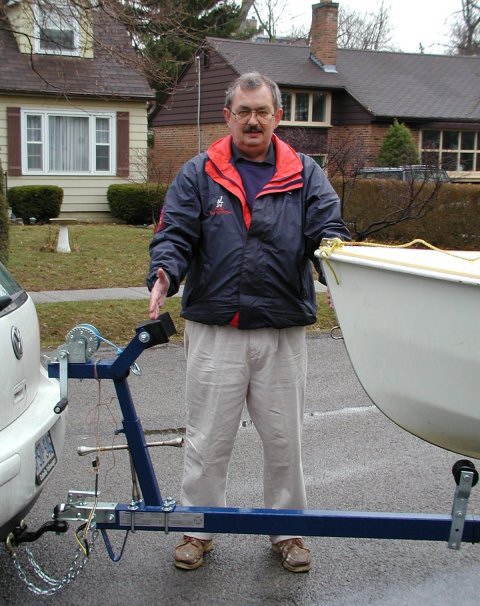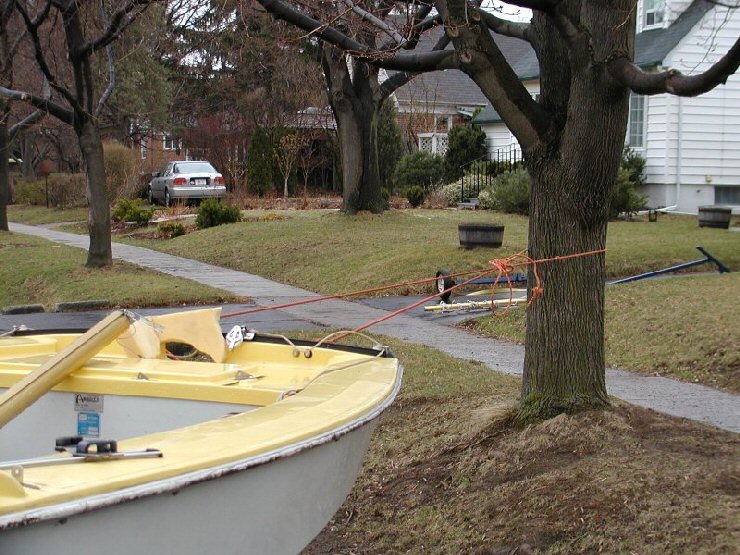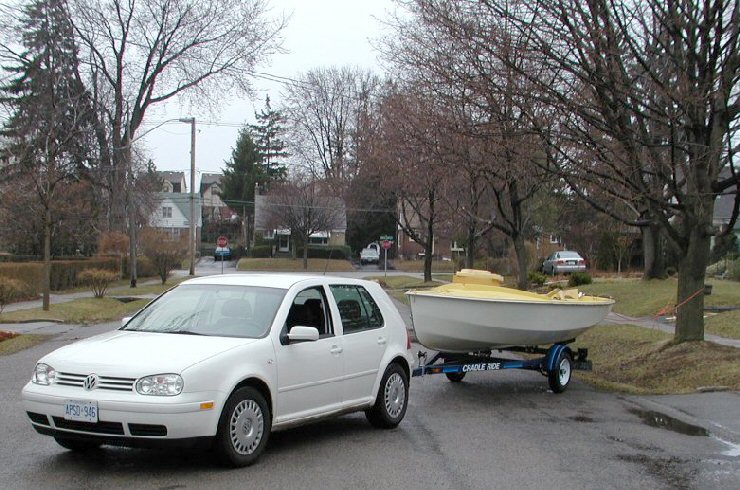| Subject:
centreboard maintenance
advice from Dick Harrington and Uncle Al a question from Jack Blodgett, new Wayfarer in the Carolinas: Hi Dick, I posted this question on the Yahoo Wayfarer forum site but thought also I'd ask you directly: You recall that I bought Nick Puryear's wooden-kit Wayfarer back in the early fall. The boat was in such great condition, I never even thought to ask him about the condition of the centreboard. I now want to know how to get the CB out to look at it - - possibly fix it up if at all necessary. Nick seemed to remember being able to get the board out while it was sitting on the trailer with the board in a fully retracted position (and to get it back in again). But he wasn't 100% sure about that - - it's been a long time, he said. Maybe this issue is too basic for people (other than myself!) to have questions about, but I could find very little about the process in any of the technical or forum info anywhere. My questions: 1. While the boat is sitting on the trailer with the CB in full-up position, can I just take out the pivot bolt and pull the CB up and out - - - and then get it back in again? I'm wondering whether the CB brake will prevent the board from coming out (unless I loosened it ahead of time while out in the water, etc.) - - - or whether, if not, it would be difficult to line up the holes in the case and CB to get it back in again while in the fully retracted position). 2. Instead, should I just go and get the boat afloat, put the board down, loosen the brake, take out the pivot bolt, and pull out the CB? (Meanwhile, will the boat start filling up with water? I have a feeling that's a question that might draw some laughter - - but ... that's just how much I don't know!) 3. If there are serious issues with the above "methods", what's the best way to do it (hopefully short of careening the boat over on its side, and assuming that I would need to do everything without any help)? 4. Assuming I get the board out and spruce it up if it needs it, is there anything else I should do with the fittings, etc. while it's apart? E.g., I think there may be a small amount of leakage around the pivot bolt - - would new rubber washers pretty much fix this? Thanks for any advice! Jack Blodgett W7978 -----
Original Message -----
<>From:
Richard Harrington
To: Jack Blodgett
Cc: Al Schonborn
Sent: Tuesday, February 20, 2007 10:51 AM
Subject: Centerboard Question
Hi Jack,
The safest way to remove the board is to bite
the
bullet and put the boat onto the grass and roll it
onto its side.
Depending upon the construction of your trailer you
can get the board
out by shifting the boat aft until there is clear
space beneath.
This is tricky because you don't want to drop the boat
and usually the
balance becomes back heavy. Some kind of
support such as a
sawhorse is necessary. (Al's
note: see also my alternative
approach below) The board will
not come out until
it is about 2/3's or 3/4's in the down position.
You can either
drop it below or take it from above. (below
requires knob removal, though!)
Getting it back in place
is a search in the haystack game with the pivot
bolt. A
trick I read about uses a string run through one side
of the hole in
the trunk, then through the board hole and out the
other side of the
trunk. This should help a great deal in getting
the holes lined
up.
Hope this helps.
DICK
----- Original Message ---- From: Jack Blodgett To: Richard Harrington Sent: Tuesday, February 20, 2007 4:23:52 PM Thanks, Dick. All makes sense. Nick
assures me
that he DID West-System epoxy the CB (and everything
else recommended
for it) so I don't really expect much of a
problem. It occurs to
me, too, of course, that I may not even have to take the
board
completely out if it looks okay or if I can fix any
minor nicks, etc.
on the spot.
One follow-up on the CB brake: I assume I need to
lower the
board low enough to also get at the CB brake - - to
loosen it before I
try to pull the board out. Yes?
Would it pay to put new washers on the pivot
bolt? I
read a hilarious "fix" for minor leakage at that point
on the UK site -
- using the "perfect-fit" washers that fortuitously come
with the
Grolsch pint-beer caps. Drink one beer for one
washer to get
ready to take the CB out, and drink another beer to get
ready to put
the board back in - - in order to get your two required
washers! (Al's
note: Heck, now that you mention it, we consumed
enough Grolsches at
the Cedar Point Rally last year to do a dozen boats.
Will have to save
the washers next time - perhaps during the
Chesapeake Cruise?)
Thanks again.
Jack
-----
Original Message -----
From:
Richard Harrington
To: Jack Blodgett
Cc: Al Schonborn
Sent: Wednesday, February 21, 2007 12:57 PM
Jack,
The
leading edge and tip of the board invariably suffer
nicks and often
much more. By now, if the boat was
been sailed much, there
should be at least minor repairs required.
So you need to
get the board in the down position and once
there, it's no big
deal to remove it entirely, inspect everything (inside
the slot,
replace the brake, which is a piece of (car
radiator) hose, and so on.
With the board down, by
using a long-shank screw driver the tension on the
brake can be
adjusted.
There
are literally hundreds of opinions regarding pivot
bolt seals.
GRP boats suffer from 'tin canning' (flexing) of the
trunk's side
panels, where as woodies, being stiffer, allow easier
sealing. Thus, things devised to deal with
GRP construction
don't necessarily apply to a wooden boat. I
use what are called fender (or pan) washers,
which are the
largest washers you can get, with a large
diameter neoprene
rubber washer to match (cut it out of 1/8" flat
stock). You won't
have any problem.
DICK
-----
Original Message -----
From:
Al Schonborn
Sent: Sunday, March 18, 2007 10:35 PM
Subject: Re: Centerboard Question
Hi, guys:
Once again, I am
at
last being moved to reply as I prepare your materials
for a Weekly
Whiffle later tonight. Being the inventor of
the saying "Laziness
is next to godliness", I am (almost) all in favour of
removing the
centreboard while the boat is on the trailer,
preferably on your front
lawn where it can raise the whole tone of your
neighbourhood at the
same time!! Dick has covered everything else
perfectly.
Regarding board
removal
and subsequent re-installation with a minimum of help,
I will however,
add my two cents' worth and list the options as I see
them, along with
pros, cons and procedures:
1. boat
stays
on trailer
procedures:
> use magic
marker
to draw a line along at least one side of the board in
its full-up
position (if you have a pin [a few inches forward of
the thwart near
the top edge of the box] that holds the board up for
on-the-trailer
storage, that should be all you need to locate the
board in more or
less the correct position for bolt re-insertion later;
otherwise, mark
the centreboard box where the front of the board
emerges from it, then
line it up accordingly for re-insertion - I use a screwdriver of appropriate size
to try to locate the bolt hole in the centreboard,
and having found the hole, I swing the screwdriver around in a
couple of circles to make sure the board hole is
as lined up as possible with the holes in the CB
box. To play it safe, I use the bolt to push the
screwdriver back out. This lets me easily make
fine adjustments as needed and guards against the
possibility of "losing" the CB bolt hole altogether and having
to start over.)
> remove bolt
> don't worry
too
much about loosening the brake (there is no lip at the
top - or bottom
- of the CB box on the wooden boats - lucky us!!) -
it's actually best
to have some amount of friction so that the board will
be inclined to
stay in the places you move it to, especially until
you get the boat
moved to a place on the trailer where you will be able
to remove the
board
> gently try
to
slide the board up and out (on W3854 the board will
come part way out
but then gets wedged because its lower edge is
obstructed by a cross
piece on my trailer)
> this means
the
boat must be slid aft on the trailer a few inches
before a second (or
God forbid third) attempt is made N.B. make
sure you put the board back into the full-up
position before trying to
slide the boat aft on the trailer - if
possible/necessary, use the
pin to hold it in that position; otherwise tie it to
the mast step
using the knobs on the upper front corner of the
board
> before
trying to
move the boat on the trailer, I hook the trailer up to
the car with the
parking brake on. This does two things: it allows my
wife and me to
physically drag the boat aft a few inches while
holding the trailer in
place, and two, it allows me to get into the boat
without fear that it
will tip over backwards and slam the aft end onto the
ground if I move
too far aft in the boat (our boat has minimal tongue
weight in normal
trailering position, perhaps 20 lbs?, so
moving the boat aft
makes the balance factor a tad precarious) (if you
have a trailer that
"breaks" make sure it is "locked" in the
no-break position. A
small aside here, even two of us once had trouble
sliding a boat we
were bringing down to Richard Johnson at the 2003
Cottonwood Regatta in
Charlotte so we resorted to the following:
 the end result - and here's how
we did it:
  It did of course require a delicate
touch on the clutch
and gas pedal - we were actually just trying to
reduce the excessive
tongue weight before making the trip from Toronto to
Charlotte!!!
Pros:
- convenience,
can be
done at home, etc.
- no need to
raise the
mast and rig it up
Cons:
- requires a
certain
amount of manhandling but nothing excessive
2. boat
is
removed from the trailer onto your front lawn
or equivalent,
preferably onto some kind of padded surface (old
sleeping bag?)
Procedure: get
lots of
bodies to help, especially if your trailer does not
"break" > rig
the mast (forestay and shrouds) > remove all
floorboards and other
loose gear from the boat > tip boat over onto its
side (hanging off
one of the shrouds will usually do it, and it's nice
to have a helper
to keep the boat from swinging sideways N.B. watch
that
the mast is in no danger of hitting power
lines!!!)
> tie or weigh the mast tip down for obvious
reasons > mark the
board as above to facilitate re-insertion
later > lower
the board full down (beware!!!
on
at least one occasion, two of us had trouble getting
the board to start
going down, and while I went to see if something was
wedged into the CB
slot in the hull, my crew really yanked on the board
which suddenly
moved violently and just missed knocking out all of
my upper teeth -
one of the scariest sailing experiences I have ever
had!) >
remove bolt and then the board (loosen brake if
desired but don't be
like me and forget to re-tighten to desired friction
level after
re-insertion and before letting the boat come upright
again) > fix
anything that needs fixing > re-insert using the
marks to help find
bolt hole > re-insert bolt (with lots of silicone
sealer between
washer and CB box, on top of what Dick has suggested)
> bring board
back up to full-up position, checking that friction
level is such that
it takes some but not excessive effort to move the
board up or down
> adjust brake as necessary (better too much than
too little
friction since a board that keeps floating into the
full-up position is
an annoyance or worse) > re-right the
boat (best
mechanical advantage for control can be achieved by
using the (cleated)
main halyard which of course gives leverage from the
top of the mast)
> winch the boat back onto its trailer (with at
least enough help to
keep the boat aligned and level - especially if you
have a trailer that
breaks, damage to your lawn can be minimized by
hooking the trailer to
your car once again - otherwise you get divots as the
angled trailer is
winched towards the boat which tends to become the
immovable object
Pros:
- board
is marginally easier to remove and re-insert
- location is
such that
the boat can be left on its side or at least upright
on the lawn while
the centreboard work is done
Cons:
- far
more work
- more
assistance
required
- potential for
hull
scrapes is greater
3.
launch boat
where it can be tipped onto its side at the water's
edge
Procedure:
similar to
the onto-the-lawn routine: launch, tip over at the
water's edge and
then proceed as for #2 (we have tried to
remove/re-insert the board
while keeping the boat upright in water deep
enough to lower the
board, but let me tell you that racing to line up all
the holes for
re-insertion while the water is gushing in, is a high
stress occupation
that I cannot recommend!!! Removing the board this way
is actually not
too bad since the bolt can be quickly re-inserted and
excess water in
the boat avoided.)
Pros:
- slightly
easier
access to the board than #1
- can be done
with
minimal help
- minimal risk
of boat
damage
Cons:
- two trips to
the
water's edge required, the second for re-insertion -
each will entail
raising and lowering the mast, time that could be
better spent having a
nap!
- far more work
than #1
- extra bolt
insertions
(1. after board removal but before re-righting the
boat unless you love
bailing 2. before the second launch prior to
re-insertion of the
board)
Boy, Jack, this
turned
into something longer than I had expected! Upon mature
reflection, I
would say that option 1 is far and away the preferable
option, and it's
one that most trailers I have seen will fairly easily
allow. And now I
just hope that this advice has not come too late.
Good luck! May
the work
go easily!!
Best regards,
Uncle Al (W3854)
|